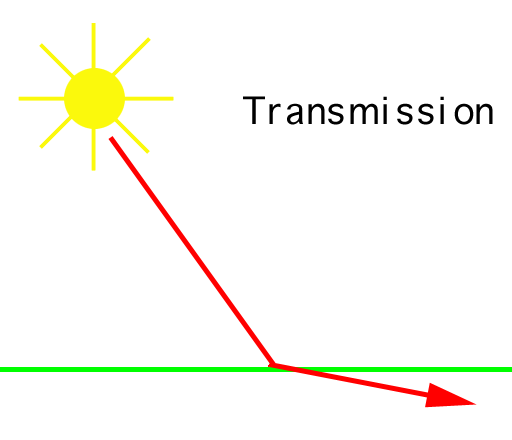
1) Light rays travel in straight lines.

2) Light rays do not interfere with each
other if they cross.

3) Light rays travel from the light sources
to the eye, but the physics is constant under path reversal. "The
Principle of Reciprocity."

1) Reflection vs. Transmission: Reflection is when
light arrives at a surface and bounces off. For example, if a person
takes a laser gun and shoots a beam of laser toward a mirror at an angle,
the beam of laser will first hit the mirror and then reflect and travel
away. Light rays behave in the same way when they encounter reflective
surfaces. When light rays encounter transparent or translucent surfaces,
however, transmission occurs. Transmission is when light passes through
the surface of an object. A familiar example of this is shooting
light rays at a prism. When the light ray arrives at the surface
of the prism, it travels through and exits at the other end.


2) Specular vs. Diffusion: A perfect reflection or
transmission constitutes a specular propagation. In this case, the
full intensity of the light ray is reflected or transmitted in one direction.
Try to imagine a basketball being bounced off of a smooth floor; Specular
reflection is the same idea. Diffusion, on the other hand, is when
the light ray leaves the surface with an equal intensity in all directions.
This time, try to imagine bouncing a basketball one hundred times at the
same spot on a rough floor. After the basketball hits the floor,
its path back up is unpredictable each time. Now imagine all one
hundred balls being bounced at the same time. The effect of one hundred
balls coming back in all different directions resemble a diffuse propagation.


3) Propagation from the Light Source vs. Propagation from the
Reflection of Other Surfaces: In a 3D environment, light arriving
at a particular surface can either come directly from a light source, or
from light reflecting off of other surfaces. Imagine a room with
only a wooden table and a light bulb mounted directly above the table.
The surface of the table is directly illuminated by the light bulb.
The space underneath the table, however, is still illuminated by light
reflecting off of the walls of the room; this is why the space is shadowed,
not pitch black.
Note: Since there are 2 possible ways light can propagate in each category, a total of eight possibilities exist. However, this is a simplified version because reflection and transmission, and specular and diffusion, are not absolute; they exist in degrees. Therefore, one can imagine the extend of computational complexity in a ray tracing algorithm.